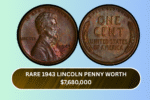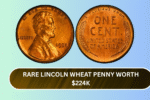Have you ever checked your pocket change and thought, “What if one of these coins is actually worth a fortune?” Well, it turns out that might not be just wishful thinking. Some rare pennies from decades ago are being sold for thousands—or even over $100,000—and one of the most talked-about is the 1943 Lincoln Wheat Penny.
This tiny copper coin could be sitting unnoticed in your piggy bank or change jar. In this article, we’ll explain why this penny is so valuable, how to identify it, and what to do if you think you’ve found one.
What Makes the 1943 Lincoln Wheat Penny So Special?
This Article Includes
In 1943, most U.S. pennies were made of zinc-coated steel because copper was needed for World War II military equipment. But by mistake, a few pennies were still made with the usual copper alloy.
These error coins—the 1943 Lincoln Wheat Pennies made of copper—are extremely rare. Experts believe that only around 20 to 40 of them were ever made.
Because of this rare mix-up, collectors are willing to pay a lot of money for this coin. In fact, one of these 1943 copper pennies sold for over $100,000 at auction, and others have fetched similar high prices depending on their condition.
How to Spot the Rare 1943 Copper Penny
So how can you tell if the penny in your hand is one of these ultra-valuable ones?
Here are a few things to check:
1. Look at the Date
It must be a 1943 penny. That’s the year this rare copper version was mistakenly made.
2. Check the Color
Most 1943 pennies were made of steel and look silver or grey. If your 1943 penny looks brownish or reddish (like normal copper), that’s a big clue.
3. Use a Magnet
Steel is magnetic, copper is not. Try placing a magnet near your 1943 penny.
- If it sticks to the magnet, it’s not the rare one.
- If it doesn’t stick, it could be copper—and you might have something special.
4. Check the Weight
A genuine 1943 copper penny should weigh around 3.11 grams. A steel one will weigh about 2.7 grams. You’ll need a digital coin scale to check this properly.
Be Careful: Fakes Are Out There
Because this coin is so valuable, many fake versions exist. Some people try to alter normal coins to make them look like the 1943 copper penny.
Here are common tricks used:
- Changing the date on a 1948 copper penny to look like “1943”
- Coating steel pennies to look like copper
That’s why getting the coin checked by a professional is very important if you suspect it might be rare.
What to Do If You Think You’ve Found One
If your penny passes the first tests (color, magnet, date), here’s what to do next:
1. Don’t Clean It
Never try to clean the coin. It can lower its value. Collectors want it in original condition.
2. Get It Authenticated
You’ll need to get it verified by a coin grading company. Trusted ones include:
- PCGS (Professional Coin Grading Service)
- NGC (Numismatic Guaranty Corporation)
They can confirm if it’s real and give it a condition grade.
3. Find Out Its Value
Depending on its condition (scratches, shine, sharpness), the value can range from a few thousand to over $100,000.
4. Decide Whether to Keep or Sell
You can either hold on to it as an investment or list it for auction. Auction houses like Heritage Auctions and Stack’s Bowers are good options for rare coins.
Are Other Rare Pennies Hiding in Your Change?
While the 1943 copper penny is one of the most valuable, there are other rare Lincoln Wheat Pennies worth checking for:
- 1944 Steel Penny – Also an error coin; worth thousands
- 1909-S VDB Penny – One of the first Lincoln pennies; very collectible
- 1955 Double Die Penny – Has a visible double image; can be worth $1,000+
So if you have a pile of old coins lying around, don’t ignore them. You might be holding a hidden treasure without even realizing it.
Final Thoughts
Finding a rare coin like the 1943 copper Wheat Penny is kind of like hitting a mini-lottery. It doesn’t happen every day—but it’s not impossible either. Keep an eye on your pocket change, especially those old-looking pennies.




